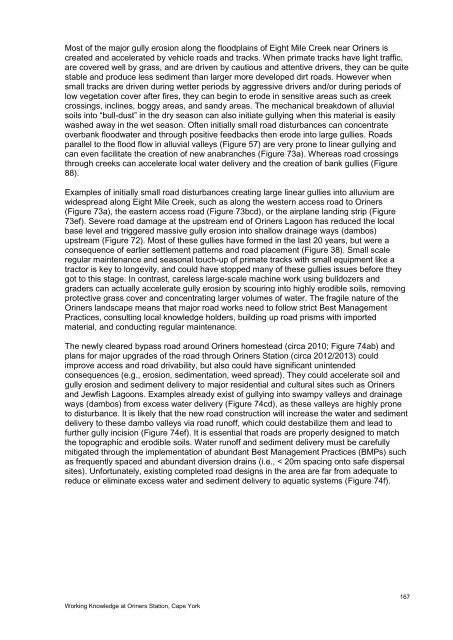WfHC - cover page (not to be used with pre-printed report ... - CSIRO
WfHC - cover page (not to be used with pre-printed report ... - CSIRO
WfHC - cover page (not to be used with pre-printed report ... - CSIRO
You also want an ePaper? Increase the reach of your titles
YUMPU automatically turns print PDFs into web optimized ePapers that Google loves.
Most of the major gully erosion along the floodplains of Eight Mile Creek near Oriners is<br />
created and accelerated by vehicle roads and tracks. When primate tracks have light traffic,<br />
are <strong>cover</strong>ed well by grass, and are driven by cautious and attentive drivers, they can <strong>be</strong> quite<br />
stable and produce less sediment than larger more developed dirt roads. However when<br />
small tracks are driven during wetter periods by aggressive drivers and/or during periods of<br />
low vegetation <strong>cover</strong> after fires, they can <strong>be</strong>gin <strong>to</strong> erode in sensitive areas such as creek<br />
crossings, inclines, boggy areas, and sandy areas. The mechanical breakdown of alluvial<br />
soils in<strong>to</strong> “bull-dust” in the dry season can also initiate gullying when this material is easily<br />
washed away in the wet season. Often initially small road disturbances can concentrate<br />
overbank floodwater and through positive feedbacks then erode in<strong>to</strong> large gullies. Roads<br />
parallel <strong>to</strong> the flood flow in alluvial valleys (Figure 57) are very prone <strong>to</strong> linear gullying and<br />
can even facilitate the creation of new anabranches (Figure 73a). Whereas road crossings<br />
through creeks can accelerate local water delivery and the creation of bank gullies (Figure<br />
88).<br />
Examples of initially small road disturbances creating large linear gullies in<strong>to</strong> alluvium are<br />
wides<strong>pre</strong>ad along Eight Mile Creek, such as along the western access road <strong>to</strong> Oriners<br />
(Figure 73a), the eastern access road (Figure 73bcd), or the airplane landing strip (Figure<br />
73ef). Severe road damage at the upstream end of Oriners Lagoon has reduced the local<br />
base level and triggered massive gully erosion in<strong>to</strong> shallow drainage ways (dambos)<br />
upstream (Figure 72). Most of these gullies have formed in the last 20 years, but were a<br />
consequence of earlier settlement patterns and road placement (Figure 38). Small scale<br />
regular maintenance and seasonal <strong>to</strong>uch-up of primate tracks <strong>with</strong> small equipment like a<br />
trac<strong>to</strong>r is key <strong>to</strong> longevity, and could have s<strong>to</strong>pped many of these gullies issues <strong>be</strong>fore they<br />
got <strong>to</strong> this stage. In contrast, careless large-scale machine work using bulldozers and<br />
graders can actually accelerate gully erosion by scouring in<strong>to</strong> highly erodible soils, removing<br />
protective grass <strong>cover</strong> and concentrating larger volumes of water. The fragile nature of the<br />
Oriners landscape means that major road works need <strong>to</strong> follow strict Best Management<br />
Practices, consulting local knowledge holders, building up road prisms <strong>with</strong> imported<br />
material, and conducting regular maintenance.<br />
The newly cleared bypass road around Oriners homestead (circa 2010; Figure 74ab) and<br />
plans for major upgrades of the road through Oriners Station (circa 2012/2013) could<br />
improve access and road drivability, but also could have significant unintended<br />
consequences (e.g., erosion, sedimentation, weed s<strong>pre</strong>ad). They could accelerate soil and<br />
gully erosion and sediment delivery <strong>to</strong> major residential and cultural sites such as Oriners<br />
and Jewfish Lagoons. Examples already exist of gullying in<strong>to</strong> swampy valleys and drainage<br />
ways (dambos) from excess water delivery (Figure 74cd), as these valleys are highly prone<br />
<strong>to</strong> disturbance. It is likely that the new road construction will increase the water and sediment<br />
delivery <strong>to</strong> these dambo valleys via road runoff, which could destabilize them and lead <strong>to</strong><br />
further gully incision (Figure 74ef). It is essential that roads are properly designed <strong>to</strong> match<br />
the <strong>to</strong>pographic and erodible soils. Water runoff and sediment delivery must <strong>be</strong> carefully<br />
mitigated through the implementation of abundant Best Management Practices (BMPs) such<br />
as frequently spaced and abundant diversion drains (i.e., < 20m spacing on<strong>to</strong> safe dispersal<br />
sites). Unfortunately, existing completed road designs in the area are far from adequate <strong>to</strong><br />
reduce or eliminate excess water and sediment delivery <strong>to</strong> aquatic systems (Figure 74f).<br />
Working Knowledge at Oriners Station, Cape York<br />
167
















